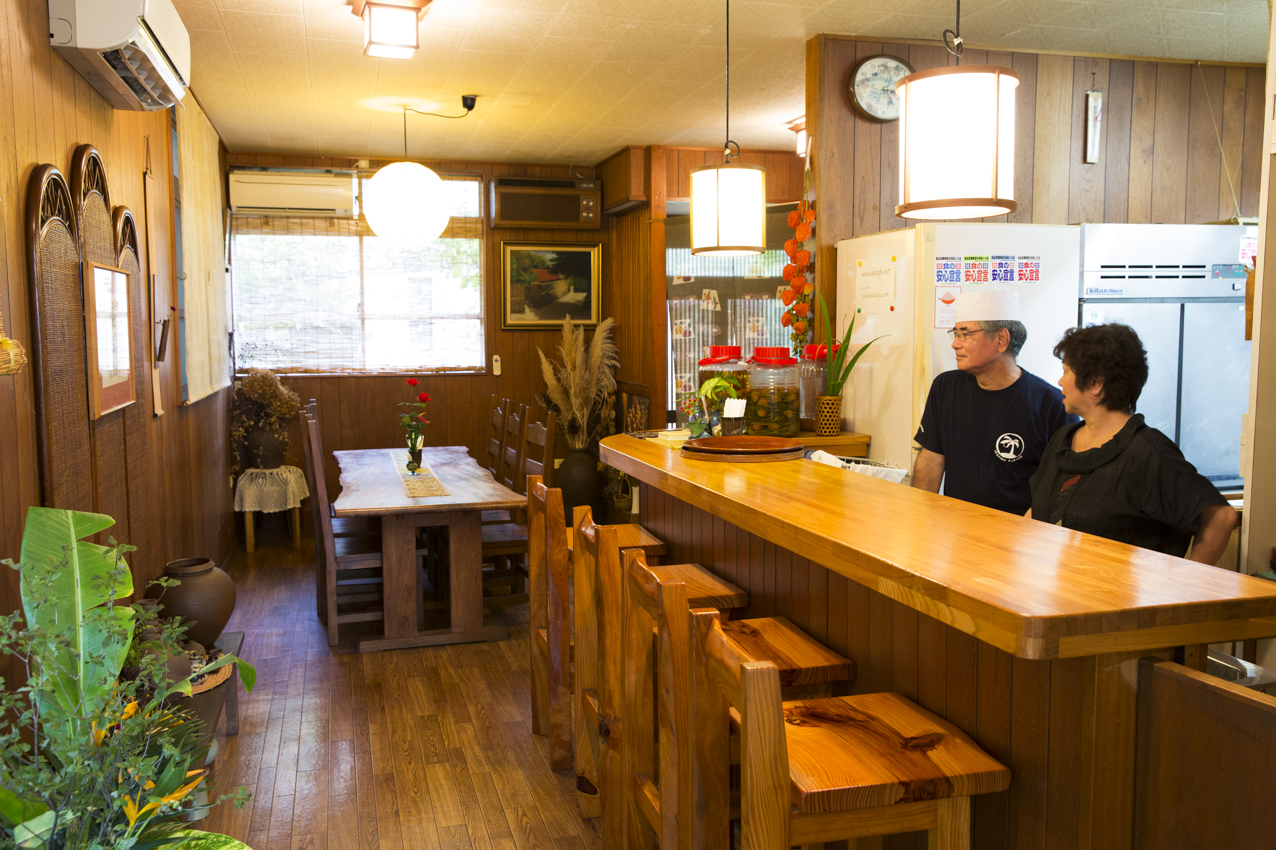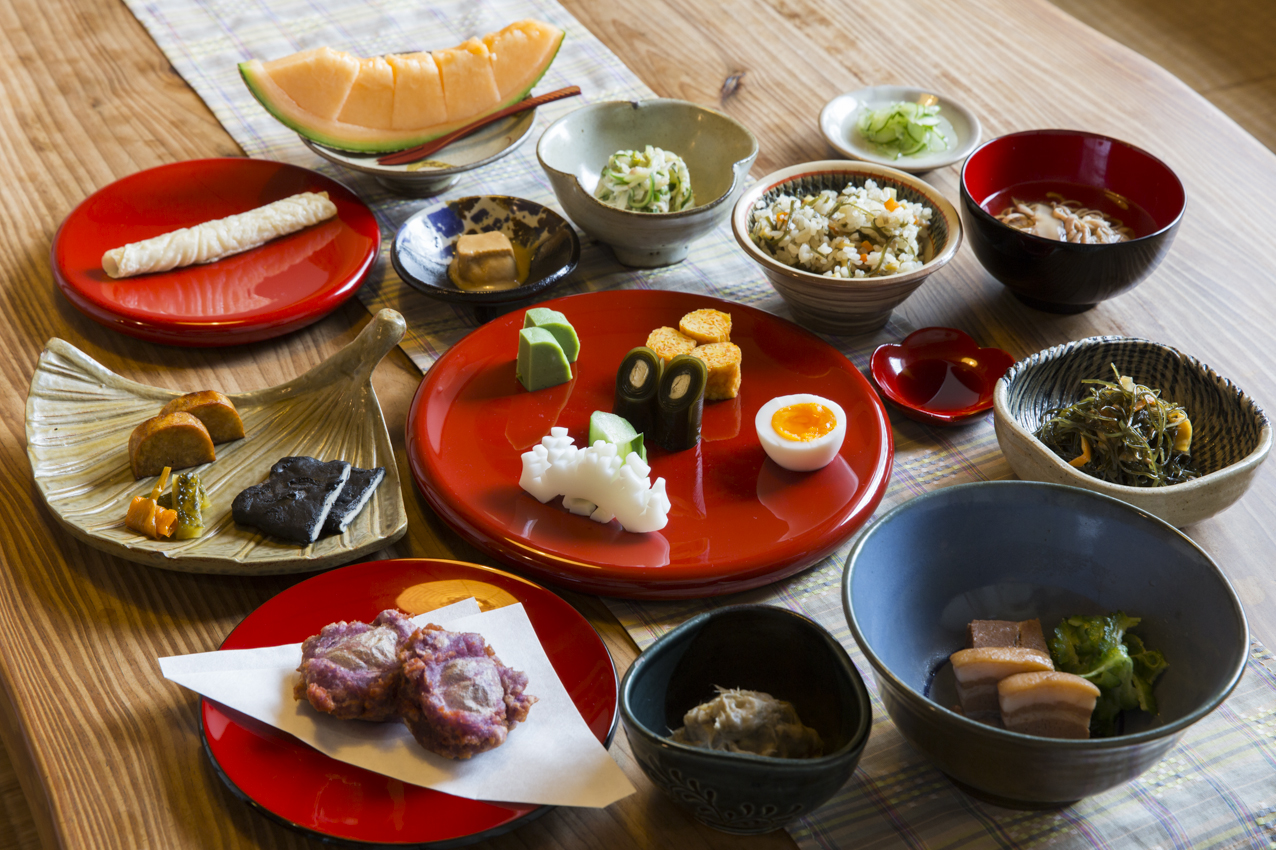TRAVELOGUE Okinawa
“Kusui-Nara-Chiku-Miso-ri” Spirit
- text : Masayuki Sesoko
- photo : camenoko studio Wataru Oshiro
- edit : nano.associates Seiji Takeuchi
chapter 3 Key to Logevity: Produce locally, cook in local unique ways
The dinner is enjoyed gradually over 2-3 hours.
To conclude my journey, I could not miss an opportunity to enjoy Okinawa kyutei ryouri (court food). I headed to the reservation-only restaurant, Akata-fu, in Shuri, Naha City. Situated in the middle of a residential area, you can enjoy the cuisine in your own time to fully appreciate its charms. The restaurant owner, Mr. Ken Shiroma, worked in the kitchen of the famous Biei restaurant for 18 years before opening his own. This true artisan says, “I just want to let people experience the beautiful world of delicious Okinawa kyoudo ryouri. One of the characteristics of Ryukyu cuisine is that it uses soup stock of meat and bonito, which gives a mild rich flavor. The seasoning and flavoring in all Ryukyu cuisine is very subtle, so that you can fully taste the great flavors of the ingredients themselves. It’s very important that you do not hesitate to devote extra time and effort in cooking each dish.” Here in this restaurant, you get to enjoy the kyutei ryouri which Mr. Shiroma continues to cook using artisan skills passed on from earlier generations. The twelve dish course starts with po-po (crepe) and goes on to nakami no osuimono (pork intestine soup), imukuji andagi (purple yam doughnut), kubu irichi (kelp sauté), rafute(stewed pork cubes) and juicie(seasoned cooked rice), etc….
The black item to the center-left in the picture is minudaru, steamed thinly sliced pork marinated in ground black sesami. The one in the middle of the front row is duruwakashi, made of taro boiled (“wakashi”) in dashi (broth) and kneaded (“duru”) until it turns gooey. In Okinawa, taro is considered an item that brings luck.
During the Ryukyu dynasty, the accredited Chinese envoys brought their “hohchu” (chefs). The Ryuku people learned culinary skills from those chefs and also from Satsuma (the then-southernmost region of Japan), then developed the special food for hospitality, Ryukyu kyutei ryouri. All kyutei ryouri dishes I experienced were very delicate, tasty, sophisticated and memorable. 
The base of Okinawan kyoudo ryouri is a broth of meat and bonito. Many dishes use those two as its ingredients too. Those dishes are aji kuta (rich in flavor). Because the broth is so tasty and flavorful, you do not need to add much salt to perfect the dish. The term ”tashiyah”, meaning stir-fry, is not just used for the wheat noodle stir-fry, but also for stir-fries using only a single kind vegetable, such as Chinese water spinach. In this style, you stir-fry the ingredient only lightly, so the dish retains the ingredient’s great flavor and texture. At the same time, because the volume of the vegetables reduces when stir-fried, you can consume much larger volume of the nutritious vegetable than if you eat it raw. Irichi is another style of cooking, in which one slowly and carefully sautés an ingredient such as dried kelp in dashi (broth). “Slowly and carefully” are the operative words! Doing so enables umami to be fully extracted from the ingredient.
Seaweeds such as sunui (mozuku seaweed) is another common staple of the region. it is full of water-soluble fibres. It can be easily digested, so much so that chewing is barely required before swallowing. Because of this, it is a great ingredient for children and elderly. Eating these seaweeds helps Okinawans to maintain a good balance of nutrition, balancing their high consumption of pork. Ms. Matsumoto told me, “There is a particular phrase in Okinawa: “dosan dosho”. It means “Use locally harvested food and cook them in local unique ways”. We believe that’s how we live our lives healthily, everything rooted in the local area. I believe dosan dosho is a very important concept.”
“Itadakimasu” (“I take in this food with gratitude”) is a typical pre-dining greeting for Japanese people. But apparently in the Okinawan dialect there is no equivalent phrase. Instead, there is a phrase, “Kusuinara chikurmisohri”, which local elderly people often use. It means, “I prey that this will be medicine to the body that consumes it”, a concept rooted in the Chinese philosophy of “Eat well to be well”. All the Ryukyu cuisine I had brought mild, tasty and rich flavors along with the taste of the solid dashi (broth) base. I could feel that goodness and richness slowly and gradually spread through my body, and each and every element was converted into my wellness and power. On the other hand, from Okinawan cuisine, I felt the toughness and willingness of the Okinawan people to adept things from the outside to convert them into their own energy and strength. It is inevitable that such culinary cultures contributed to the Okinawans’ famed longevity.
If you go to Okinawa, enjoy those three distinct cuisines to fully experience the land. You should be able to feel and learn the history and uniqueness of the area by tasting those great flavors. So, after travelling through the area, fully enjoying the three kyouro ryouri, I am officially content. “Kusuinaibitan” everyone*!
*Kusuinaitiban: A unique Okinawan phrase at the end of a meal, meaning “Thank you for the great food!”)
[offer, num=4]

